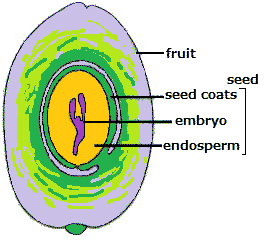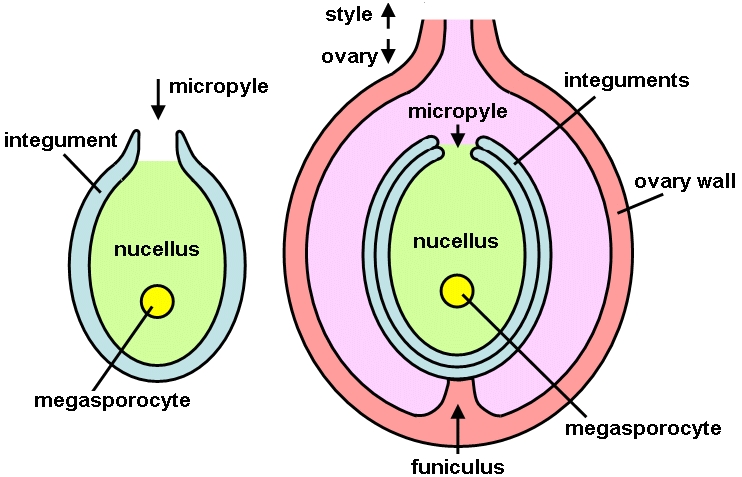(Upload on November 1 2024) [ 日本語 | English ]
Mount Usu / Sarobetsu post-mined peatland
From left: Crater basin in 1986 and 2006. Cottongrass / Daylily
HOME > Lecture catalog / Research summary > Glossary > Morphology > Seed
Seed (種子)≡ fertilized ovules of a flowering plantfertilization → ovule → development of embryo and albumen → seed development (generation of fruits) [ovary + appendages] → seed formation  A seed of angiospermae.  A seed of gymnospermae, not producing fruit. |
[plant anatomy, plant morphology, seed germination] Plumle (幼芽): the shoot tip with a pair of miniature leaves |
Ovule ______Gymnosperm_______________Angiosperm |
Juncus effusus L. var. decipiens Buchen. Polygonum weyrichii Fr. Schmidt ex Maxim. seedbank (埋土種子), seed dispersal (種子散布), seed germination (種子発芽) |
the outer integument of a seed
Roles of seed coats, including nut wall
|
|
Arillus (pl. aril) (仮種皮): a tissue surrounding the seed in certain fruits such as pomegranates, often arising from the funiculus
Funiculus (珠柄): a stalk connecting an ovule or a seed with the placenta |
Related to animal dispersalElaiosome (エライオソーム): fleshy structures that are attached to the plant seeds
rich in lipids and proteins → carried (= dispersed) by animals, mostly by ants |
Pericarp (果皮)= exocarp (epicarp, 外果皮) + mesocarp (中果皮) + endocarp (内果皮)Classification, based on number of ovaries in the fruit 1. simple fruit (単果): berried from a single flower and single pistil 2. aggregate fruit (分離複果): derived from a single flower and more than one pistil. Ex. raspberry (Rubus), strawberry (Fragaria) |
3. multiple fruit (集合果, 多花果, 複果): derived from a cluster of flowers (= inflorescence)
sorosis (肉質集合果): derived from just the pistils of many unisexual flowers of an inflorescence. Ex. mulberry (Morus) |
|
1. fruit fleshy, usually indehiscent (not splitting) _____ succulent fruit (多肉果) (adj. fleshy 肉厚の/多肉の)
2. flesh of fruit derived from a hypanthium that surrounds the papery carpels _____ pome (梨状果/梨果) Ex. apple, pear, quince (マルメロ) 3. pericarp with an outer fleshy layer and an inner bony layer (the stone) _____ drupe or stone fruit (核果/石果): (= putamen 果核 = 種子) Ex. peach, cherry drupelet (小核果): each of small, individual drupes in an aggregate fruit, represented by Rubus
3. pericarp without an inner bony layer, more ore less fleshy throughout _____ berry, bacca (液果/漿果): Ex. tomato, grape
simple berry (単漿果): berry consisting of mono-carpel Ex. Schisandraceae, Berberidaceae 4. septa evident in crossection; the outer layer leathery _____ hesperidium (柑果/ミカン状果) represented by citrus (柑橘類)
4. from a simple pistil, often with a thin shell but not bony 1. fruit dry at maturity, dehiscent (adj. 裂開性の) or indehiscent (adj. 非裂開性の) - dry fruit (乾果)2. fruit indehiscent (not splitting open) - indehiscent fruit (不裂開果, 閉果) 3. with one or more wings - samara (翼果, 翅果): wing derived from the elongation of pericarp (maple, ash, elm) (s.s.) wing-like on a part of pericarp → not including wing derived from calyx 3. without wings 4. from a composed pistil, becoming hard and bony-shelled - nut or nutlet if small (堅果): Ex. oak, walnut, hazelnut
nutlet, nucula, nucule, nuculanium (小堅果): small nut(often categorized into achene) Ex. Polygonum, Betula, Carex 4. from a simple pistil, often with a thin shell but not bony |
5. pericarp fused to the seed _____ grain (caryopsis) (頴果/殻果): Ex. rice, wheat, corn cypsela (pl. -e) (下位痩果, 菊果): false fruit, consisting of plural carpels on ovary inferior and fusion of pericarp and calyx tube, generally categorized into achene 2. fruit dehiscent (splitting open) _____ dehiscent fruit (裂開果) (dehiscing 裂開している) 3. from a simple pistil (one carpel) 4. splitting on two suture (consisting of one carpel dorsabdominally dehisced) - legume (豆果) or pod (莢果) Ex. Fabaceae (pea, bean, alfalfa) loment (節豆果, 節果): having constrictions between the seeds and that breaks into one-seeded segments at maturity 4. splitting on one suture - follicle (袋果) Ex. milkweed, larkspur, peony 3. from a compound pistil (carpels two or more, united) 4. carpels separating from other but each retaining its seed - schizocarp (分離果) or mericarp (分果) Ex. parsnip (Pastinaca sativa), carrot, spignel (Oenanthe javanica, セリ), honewort
in Apiaceae characterized by two one-seeded carpels which split apart at maturity - cremocarp (双懸果) 4. carpels splitting, releasing one or more seeds 5. fruit two-celled carpels, the two valves splitting away from a persistent, thin partition or septum (replum 隔膜) - silique and silicle (角果)
6. long types - silique (長角果) Ex. rape, radish 5. fruit one-to-several-celled, the partition not persistent if the fruit is two-celled - capsule (蒴果)
loculicidal capsule (胞背裂開蒴果) 6. opening by a lid - circumscissile capsules (circumscissile, adj. 横に裂ける)
7. with a single seed - utricle (胞果) Ex. pigweed, Chenopodium album, Amaranthus
6. opening by holes near the top - poricidal capsule (孔開蒴果) Ex. poppy
7. splitting on the septae - septicidal capsule (胞間裂開果) Ex. yucca, Hypericaceae, Linaceae, Elatinaceae, Lythrum, Rotala) |